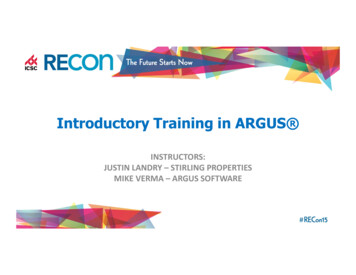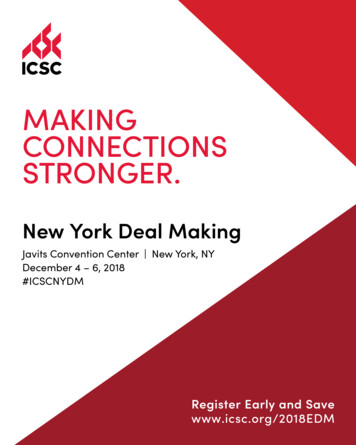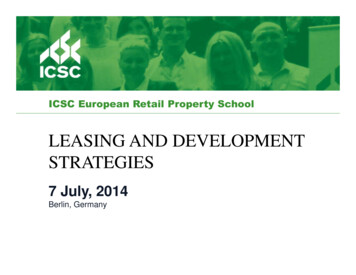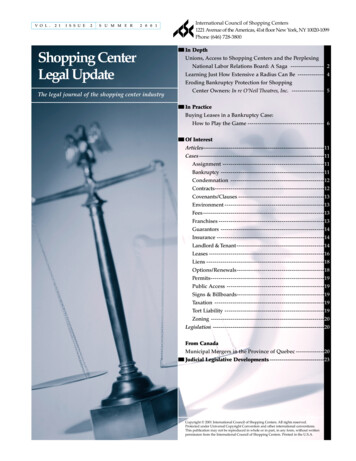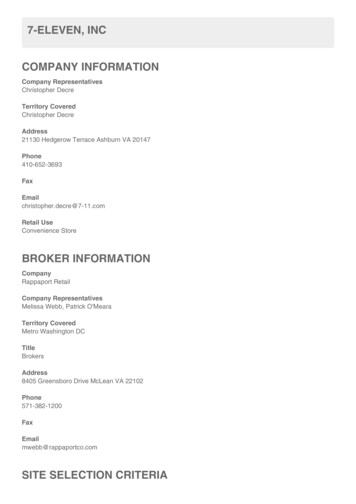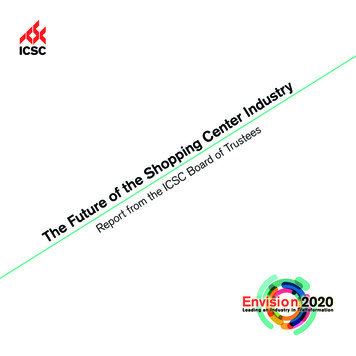
Transcription
yrtsudnIretn eeseCstrugTniofpdp oaroBShehTCSehICtefthoeomrrftu portuFeR
2
4Introduction5CONTENTSBold Statement #1: Unification of Bricks-and-Mortar and Online Retail8Bold Statement #2: Unprecedented Intimacy with the Consumer12Bold Statement #3: Conversion of Shopping Centers Into Communities16Bold Statement #4: Mall Environments that Engage Millennials23Bold Statement #5: Incorporating Distribution Into Shopping Centers27Bold Statement #6: Accelerated Developer–Retailer Collaboration30Bold Statement #7: Emergence of a New Blended Rental Model35Bold Statement #8: Arrival of a Retail–Friendly Investment Outlook38ConclusionProject Director: Eric Hertz, CAEWriter and Researcher: Anna RobatonEditor: Edmund ManderDesign and Layout: Jodi Contini
IntroductionThe retail real estate industry is undergoing one of themost profound transformations in its history. The rapidadvance of technology and the growing influence of themillennial generation, among other trends, have createdboth new challenges and opportunities for shoppingcenter owners.In light of this, how will the modern shopping center bedifferent five years from now, and how can organizationsposition themselves for success in what is likely to be aradically different business environment?Over the past year, the International Council ofShopping Centers (ICSC) and its global Board ofTrustees embarked on a project, titled Envision 2020,aimed at identifying a way forward for the industry byshining a light on the best practices and themes shapingretail real estate. Those findings, referred to as “boldstatements,” are chronicled in this report.In the following pages, you will find an overview ofeight game-changing concepts identified by the Boardof Trustees after extensive internal debate and inputfrom multiple stakeholders. Also presented here are anumber of case studies of projects and company-levelinitiatives that embody one or more of these concepts, whichare largely interrelated. In addition, the report featurescommentary from many thought-leaders, including in-depthinterviews with the top executives at some of the largestand most-respected shopping center companies.Michael P. Kercheval, ICSC President & CEOStephen Lebovitz, 2015 – 2016 ICSC Chairman4
Bold Statement No. 1: Bricks-and-Mortar and Online RetailAccording to the findings of the Envision 2020 project, shopping centers are on their wayto becoming true e-commerce participants, through increasingly sophisticated websites,onsite digital interfaces with consumers, and mobile communications to shoppers withinthe mall and beyond its boundaries.Conversely, e-commerce retailers — from Bonobos to the mighty Amazon.com with its new pop-up stores —are rolling out brick-and-mortar stores in an effort to solidify their brands and curate their product assortments. Aswe look to the future, a hybrid form of commerce is emerging, one in which shoppers move seamlessly betweenthe physical and digital worlds of retailing as they research products and make purchases.According to the Fung Business Intelligence Centre, “showrooming” — the practice of researching a productin the store but buying it online — gets plenty of attention, but recent studies suggest it is far less common than“webrooming,” which entails researching a product online and then purchasing it in a store. In fact, 90 percentof all U.S. retail sales still occur “within the four walls of a physical store,” according to a report by managementconsulting firm A.T. Kearney.“ It seems as if every day there is an e-tailer announcing it is openingphysical stores. At the same time, our retailers are investing intechnology to deliver a platform that meets their customers’ needs.” Stephen Lebovitz, president and chief executive officer of CBL & Associates Properties, Inc.(He is also the 2015 – 2016 chairman of ICSC)The Promise of TechnologyIn 2012, Westfield created Westfield Labs — an entity dedicated to digital innovation. Over the last severalyears, Westfield Labs has piloted a number of programs aimed at making it easier to shop and dine at thecompany’s centers, thus increasing foot traffic.Among other initiatives, Westfield Labs has rolled out ticketless, smartphone-enabled parking at WestfieldLondon and food-ordering apps for Westfield San Francisco Centre and Westfield Sydney. Its Westfield appproduct-search feature allows consumers to search for specific items, view product information and pricing, findout which tenants at their preferred Westfield center carry the items and “click to call” the stores. Westfield iscapitalizing on the fact that 50 percent of all retail purchases are influenced by information consumers find online,according to the company.5
In China, the Dalian Wanda Group Co. Ltd., a commercial property, hotel and film conglomerate, has formedan e-commerce joint venture with Tencent Holdings, a social media giant, and Baidu Inc., the country’s dominantsearch engine. The trio has ambitious plans to create the world’s leading online-to-offline e-commerce platform,whereby consumers use their smartphones to find and purchase goods and services, often from nearby stores.Wanda plans to promote its portfolio of more than 100 malls to the hundreds of millions of users of online chat,search and payment services developed by Baidu and Tencent, according to Forbes magazine.Meanwhile, Unibail-Rodamco, Europe’s largest listed commercial property company, has established aninnovation incubator, UR Lab, that is working with internal and external stakeholders, including retailers, tomonitor trends, test concepts and implement the strongest ideas at the company’s shopping centers. Accordingto the company, UR Lab is “reinventing the retail experience” by “using technology to bring the physical anddigital worlds closer together,” among other initiatives. Since its founding in 2012, UR Lab has rolled out newretail concepts and digital tools, such as Meet My Friends, an “indoor geosocial networking” service accessedvia the mobile apps of Unibail-Rodamco’s shopping centers.Westfield London6
Q&A withSteven LowyCo-Chief Executive OfficerWestfield Corp.This year, Westfield was named one of the 50 mostinnovative firms in the world by Fast Companymagazine, along with the likes of Google and Apple.With the creation of Westfield Labs and other initiatives, you seem to be developing a new modelfor Westfield. Can you discuss your vision for the company?Lowy: You are seeing a very serious trend of the convergence of physical and digital retailing, with consumerssearching online and buying offline; searching offline and possibly buying online; or buying online andthen picking up in the store. There is a crossing of paths between the physical and digital. At the end ofthe day, you are selling consumers something in the most convenient and cost-effective way. Historicallythe business model for the shopping center industry has been to connect consumers and retailersphysically. It was the retailers’ job to convince consumers to buy something. That model is shifting as aresult of technology. The real estate owner now has a large part to play in connecting the retailer andconsumer both physically and digitally, and to do that you need a direct relationship with the consumer.How might the shopping center lease model change as a result of the reframed relationshipbetween landlords and retailers?Lowy: The provision of the real estate itself will only be one part of the overall service that real estate providerswill be able to offer to retailers. That will require leadership on behalf of leading retailers and real estateproviders. Both are starting to invest heavily in technology, and for that technology to work together,commercial arrangements will need to be put in place.What can you tell us about your vision for Bespoke, the new 37,000-square-foot event andtechnology-demo space at Westfield San Francisco Centre? It is unlike anything the industry hasseen before. To what extent is it a consumer attraction? What role does it play for Westfield?Lowy: It is a hub for innovation, a physical place to connect retailers and technology providers in a real-worldenvironment. It is a unique repurposing of real estate. It is an opportunity to fast track the embracing oftechnology by the retail community to better serve the consumer.Like some other large mall owners, Westfield is offering same-day delivery service from variousproperties. Do you see malls evolving into flexible formats where they function partly asdistribution centers for retailers?Lowy: I have no doubt that will happen. The technology is all being tested. This is about connecting the stockin the stores to the consumer and getting it to their home or office, or making it easier for them to comepick it up.7
Bold Statement No. 2: Intimacy with the ConsumerAccording to the Envision 2020 project, developers and retailers will leverage technologyto embrace the human experience through an enhancement of customer outreach bothinside and outside of the retail environment.The DisruptorsAccording to the Fung Business Intelligence Centre, there are a handful of emerging technologies that have thepotential to disrupt the retail sector. Not surprisingly, they include mobile apps. More than a billion smartphonesare sold each year and app developers are creating products for “every imaginable use,” including anytime/anywhere shopping, according to a Fung report. “Tiny sensors in smartphones gather data about the physicalworld, including location and movement, allowing for the development of applications for in-store promotions andback-room efficiency,” states the report.The advent of beacons also has big implications, according to the report. These compact, inexpensive Bluetoothtransponders “can be installed throughout stores and other spaces to provide continuous connectivity withconsumers, track activity on the shopping floor and transmit data to consumers and associates,” states the Fungreport.Arabian Centres, Mall of Arabia/Jeddah, Saudi Arabia8
Beacons in the Common AreaShopping center owners, like many of their larger tenants, have embraced mobile apps, beacons and the like.In some cases, they are making these platforms available to their tenants. Simon, for instance, has outfitted itsmalls with beacons that send offers and information to shoppers’ smartphones as they stroll through a property.The company is also rolling out digital directories and concierge services that help mall visitors find their wayaround properties, locate deals and get information about events.Indeed, new technology is empowering shopping center owners and retailers like never before.In Saudi Arabia, Arabian Centres Company Ltd. has begun using mobile-phone tracking technology to geta better understanding of the traffic patterns within its malls and spot opportunities to improve its properties interms of merchandising, revenue and amenities.“ We can track clients to see where they go and identify hot and coldspots within the malls.”Simon Wilcock, chief executive officer of Arabian Centres Company Ltd.Through its mobile apps and associated tracking mechanisms, Arabian Centres is able to gather generaldemographic information about shoppers and send tailored offers to their smartphones even before they arrive atthe mall, explained Wilcock. The company is capitalizing on the fact that smartphone penetration in Saudi Arabiais high (about 75 percent), according to Wilcock. “Our digital initiatives have helped us to determine whether weare delivering something shoppers want,” he said. “You can only build community if you are delivering somethingthat local consumers want.”Back in the United States, Kimco Realty Corp., the largest U.S. owner of open-air centers, is using its WestCoast flagship property, Westlake Shopping Center, in Daly City, Calif., to pilot various technologies. Amongother initiatives, Kimco is using an analytics program at the open-air center to gain insight into cross-shoppingpatterns and other issues.Social Media InsightsFor some developers, social media has become more than just a marketing tool. As it was making design andleasing decisions for Avalon, a 600 million, mixed-use project in Alpharetta, Ga., North American Propertiesundertook a “design-discovery tour” of different types of properties and documented its journey on Facebook andother social media sites. The company asked the public for feedback on various design ideas and retail concepts.9
“ We really listened to the community and wanted to make sure thatwhat we were creating [at Avalon] would resonate with the market.”Liz Gillespie, vice president of marketing of North American PropertiesAs they vie for the attention of time-starved, tech-savvy consumers, shopping centers are coming to look, feeland function differently than the retail fortresses of yesteryear. From a leasing standpoint, many landlords arekeen to add so-called experiential retailers and restaurants, including popular local and regional concepts thatappeal to millennials. Hotels, health clubs and other non-traditional tenants are becoming more prevalent, as arethoughtfully designed public spaces for recreation and entertainment.North American Properties, Avalon, Alpharetta, Ga.10
Case Study:Kimco Realty Corp.Kimco Realty Corp. has given Westlake Shopping Center, itsWest Coast flagship property, a high-tech makeover designed toengage customers, increase sales and generate analytic insightsthat inform decisions about the property.Last year, Kimco installed Wi-Fi at the open-air center in Daly City,Calif., in an effort to determine whether the complimentary servicewould increase the amount of time visitors spend onsite, ultimately driving higher sales per customer. The Wi-Finetwork was also intended to serve as a platform for adding other services to the center.Kimco, Westlake Shopping Center, Daly City, Calif.What Kimco has learned is thatvisitors who log in tend to spendtwice as long at the property asthose who don’t. Tenants are alsousing the network as a tool to drivemore foot traffic to their stores.Retailers display information abouttheir offerings and specials, as wellas links to their websites, on thenetwork’s mobile web portal.After installing Wi-Fi last year,Kimco added computer-visionsensor technology that allows it tocount the number of vehicles andpedestrians throughout the siteas well as determine directionality,utilization of space within thecenter and the general flow ofpedestrians from different points.“A lot of this type of data was inferred in the past,” explained David Jamieson, Kimco’s executive vice president ofasset management and operations.Kimco will continue to add technology to the center to better serve both shoppers and tenants. It plans, forexample, to add geo-fencing technology that would allow tenants to transmit offers and information to shoppersvia their smartphones as they stroll through the center. “When someone walks into the center, their iPhone mightbe pinged with an advertisement or with a message alerting them to an in-store special,” said Jamieson.11
Bold Statement No. 3: Shopping Centers Into CommunitiesAccording to Envision 2020, shopping centers are evolving from simple retail propertiesinto shopping, dining and entertainment centers that are central to, and fully integratedwith, the communities that surround them.To remain relevant, large-scale retail projects must be more than just “a distribution center for goods,” saidYaromir Steiner, chief executive officer of Steiner Associates.“ You have to create a place that will become the center of people’slives.”Yaromir Steiner, chief executive officer of Steiner AssociatesSteiner Associates is set to unveil a mixed-use project in the greater Cincinnati area that features several parks,a nondenominational chapel and a “community house” that can be rented for wedding receptions and otherfunctions.For its part, Kimco Realty has taken a hard look at its portfolio to identify opportunities to incorporate apartments,hotels, cinemas, health clubs, additional restaurants and other types of uses that add density, foot traffic andvibrancy.Many of Kimco’s centers were built decades ago and serve markets that have become denser over time. Thecompany has preliminarily identified about 40 centers in its portfolio that have the potential for redevelopmentinto mixed-use properties.Shopping Centers as Cultural HubsIndeed, shopping centers are coming to play a greater role in the cultural life of their surrounding communities.Some properties, like Liberty Center (the mixed-use center co-developed by Steiner Associates andBucksbaum Retail Properties, and opening this year in Greater Cincinnati) are monetizing their public spacesthrough sponsorship arrangements with businesses that get naming rights and limited use of the facilities foroutreach events. Other centers, such as Centro Comercial Santafé Mall in Medellín, Colombia, are able tooffset event-related costs through ticket sales.12
In an effort to set itself apart from the competition and make its expansive main plaza more welcoming, Santafé, asix-level enclosed mall, began holding regular large-scale events in the plaza shortly after it opened in 2010. Theevents, which are produced in-house and change every two months, have become so successful over time thatthe mall now charges a minimal admission price. Visitors are also required to spend a certain amount at the mallto gain admission to the events. Some of the most-popular of these have included an elaborate “futgolf” courseto coincide with the last year’s World Cup in Brazil; a giant ball pit that attracted 140,000 people during a 14week period; and an intricately designed “flower carpet” to coincide with the city’s annual flower fair.Santafé Mall, Medellín, ColombiaThe only enclosed mall in Medellín, Santafé is situated near two other highly successful shopping centers. Overthe past five years, it has become the city’s highest-grossing mall in terms of sales, and a social hub, thanks inlarge part to its popular events. Between 2010 and 2014, the mall’s yearly traffic count more than doubled toalmost 14 million.“When we first opened, the main plaza felt very cold and uninviting. It became like a liability for us,” said JuanitaGutierrez, the mall’s general manager. As a venue for large-scale events, the plaza has become an asset, sheexplained. “You need to give people reasons to come together. They can shop anywhere, anytime, but it is theexperience you provide that makes the difference,” Gutierrez said.“ We want [Santafé] to be like a Happy Meal. It has a meal, but it’sthe surprise that comes along with the meal that makes the wholedifference.”Juanita Gutierrez, general manager, Centro Comercial Santafé13
In the Middle East, the shopping center industry is evolving to include a greater number of smaller-scale projectsthat provide both convenience and a tailored retail experience, according to Michael Cesarz, chief executiveofficer of the shopping center unit of Majid Al Futtaim Properties, based in Dubai.“We are seeing a notable shift from the supercenter culture to smaller formats. While the supercenter conceptwill not go away, the smaller formats will become more dominant, as they better meet the needs of increasingurbanization and consumers’ changing notion of convenience,” he said.The conversion of shopping centers into communities reflects an effort on the part of many landlords to court theall-important millennial generation, which, in the United States, is projected to surpass baby boomers this year asthe nation’s largest living generation, according to the Census Bureau. Also known as Generation Y, millennialsare those born roughly between 1980 and 2000. There are some 2.5 billion of them worldwide, representingabout a third of the global population, according to a Viacom study.Steiner Associates, Liberty Residential, Cincinnati14
Case Study:North AmericanPropertiesIn 2011, North American Properties acquired a stalled, mixed-usedevelopment in Alpharetta, Ga., and set out to reimagine theproject. Three years later, the company unveiled Avalon, theSouthern USA’s first “urbanburb,” a vibrant, sustainably designedmixed-use property that has cultivated deep emotional ties to thesurrounding community.Alpharetta, known as “the technology city of the South,” is a suburb of Atlanta that has enjoyed strong growthin population and household income over the past couple decades. “We knew there was an opportunity tocreate something really special in Alpharetta,” said Liz Gillespie, vice president of marketing for North AmericanProperties. “Our ultimate goal was to create a third place. After home and work, we wanted people to think ofAvalon as their third place,” a place that offers meaningful value, generates memorable experiences and fostersbetter relationships among people, explained Gillespie.NAP has positioned Avalon toappeal to what it calls the “new-classconsumer,” rather than targeting aspecific demographic group. The“new class consumer,” explainedGillespie, is not defined by age,but rather by lifestyle. He or sheis someone who values wellness,sustainability, technology, communityand local concepts.North American Properties, Avalon, Alpharetta, Ga.Ultimately, NAP put together a mixof aspirational retailers and diningconcepts created by 15 of Atlanta’smost-celebrated chefs and JamesBeard-nominated restaurateurs.According to NAP, many of Avalon’s tenants are generating nearly 1,000 per square foot in sales. The propertyis also commanding above-market office rents, and its luxury apartments and single-family homes have alsoperformed well.There is also plenty of anecdotal evidence to illustrate the strong following Avalon has cultivated, says Gillespie.Avalon, she notes, draws big crowds even when the stores aren’t open. “People have gotten used to it being theplace to go. On Easter Sunday, people were congregating in the plaza with their kids, playing bocce, and kidswere on the swings,” she said, “yet most of the shops and restaurants were closed.”15
Bold Statement No. 4: Engaging MillennialsAccording to the findings of the Envision 2020 project, shopping centers will provide amore customized, personalized appeal to attract and engage the younger customer. Therewill be a heightened level of coordination between developers and retailers in creating aseamlessly attractive and entertaining environment.What Millennials WantThere are commonalities among millennials that have big implications for retailers and shopping center owners.Contrary to popular belief, most millennials (82 percent) prefer to shop in stores, although they spend a greatdeal of time browsing and researching products online, according to a study by JLL.Millennials are savvy, price-conscious shoppers, yet theyalso tend to place a high value on experiences, perhapsmore so than on the acquisition of material goods,according to Morley Winograd, a researcher specializing inthe millennial generation. One of the experiences they valuemost is eating out, and that has contributed to a proliferationof restaurant concepts. As of the first quarter of this year,openings by food retailers represented nearly 40 percentof the planned store openings for the next 12 months,according to JLL. “This is a generation not only of techies,but foodies, both eager to go out and try new restaurants aswell as to create fun, tasty food at home,” noted JLL.As a group, millennials are also keen to make a differencein the world, and thus favor companies that prize socialresponsibility and environmental sustainability. “Millennials,”JLL noted, “want to believe in the companies they patronize.”Many existing U.S. shopping centers were built in theburgeoning post-World War II suburbs, but millennials intheir young-adult years apparently prefer city living, thoughthat may change as they marry and have children. Accordingto Nielsen, 62 percent of them say they prefer to live inthe type of mixed-use communities found in urban centers,largely because of the job and social opportunities.Millennials prefer to live in mixed-use communitiesfound in urban centers16
“ We have looked at our portfolio in depth to analyze the best waysto create that 24-hour, shop-work-play experience and integrating itinto the local community.”Conor Flynn, president, chief operating officer and incoming chief executive officer of KimcoRealty Corp.Urban RenewalThe influx of well-educated, young-adult millennials to major cities has given rise to stronger retail, apartmentand office demand in certain downtown markets, creating opportunities to reposition existing urban centers andundertake a limited amount of development.In downtown Los Angeles, Brookfield Property Partners has taken a once-ailing center and repositioned it toserve the large number of millennials who now live and work in the market. Called Figat7th, Brookfield has addednew retailers and food-court concepts created by local chefs and restaurateurs with a strong following on socialmedia. The center has a robust events schedule, and many of its programs are arts-focused.In Latin America, Mall Plaza, aChile-based retail developmentcompany that owns more than adozen centers in the region, hassought to position its propertiesas social hubs for surroundingcommunities.Brookfield Property Partners, Figat7th, Los Angeles“In Latin America, the economyis growing and people now havemore options in terms of how theyspend their leisure time,” said MariaElena Guerrero, Mall Plaza’s head ofmarketing for Latin America. “Thatis why we are focusing not just onshopping and dining, but also onentertainment. Millennials are lookingfor high-value experiences.”17
The company has enhanced its mall apps, added restaurants and amenities to its properties (from bicycle racksto a public library), and relied heavily on social media to engage consumers and build its brand. Its Mall PlazaFacebook page has some 1.5 million followers in Chile. Each year, the company produces a large-scale musical,which is shown for free at its shopping centers in Chile and streamed on the web.Mall Plaza Egaña, Santiago, ChileLast year, at Mall Plaza Oeste in Santiago, the company replaced an above ground parking lot with a lagoonsurrounded by restaurants. It also added a playground for children. “We decided to put the parking undergroundso that we could use that space to build a very big lagoon surrounded by restaurants,” explained Guerrero. Thecenter serves a populous market, where there are few homes with yards.“ Real estate is a social science. Investors need to understandconsumer behavior to understand the rationale behind theirassets.”Mark Stapp, executive director of the Master of Real Estate Development program at ArizonaState University18
“ When someone walks into the center, their iPhone might be pingedwith an advertisement or with a message alerting them to an instore special.”David Jamieson, executive vice president of asset management and operations of KimcoRealty Corp.As they woo millennials, developers are not only adding restaurants and new retailers, but also placing a greateremphasis on sustainability. In 2012, Hong Kong’s Parkview Group opened the first LEED Platinum-certified,mixed-use property in Asia. The property, Parkview Green in Beijing, contains a four-level shopping centerwhose tenants include high-end, socially conscious retailers, from fashion chain Stella McCartney to electric-carpurveyor Tesla Motors. The complex has become a magnet for affluent locals, including large numbers of youngfamilies drawn by its extensive art collection and other features.In the Middle East, Majid Al Futtaim Properties has embarked on an ambitious sustainability program. As aresult of its efforts, City Centre Mirdif in Dubai, one of the largest malls in the world, has achieved the U.S. GreenBuilding Council’s LEED Gold EBOM (Existing Buildings Operation and Maintenance) rating. Over the courseof 18 months, the company worked with more than 500 retailers at the three-million-square-foot mall to achieveenvironmental targets in a number of categories, from water efficiency to green cleaning practices.“The harsh Middle East climate previously excluded buildings from achieving LEED EBOM because of the highamount of energy consumption used for cooling and the complex nature of integrated malls in the region,” saidCesarz, chief executive officer of the company’s shopping center unit.On the Suburban FrontSuburban centers are also morphing to cater to millennials. CBL & Associates Properties, Inc., one of thelargest U.S. mall REITs, is seeking to position its suburban malls as town centers. To this end, the company isconsidering adding new uses, such as apartments and hotels, as space becomes available at its properties.U.S. shopping center occupancy rates hit a six-year high in 2014, reaching 92.7 percent, according to ICSC.Mall occupancy rates stood at 94.2 percent last year, the highest level since 1987. In light of that, CBL will lookto repurpose space vacated by contracting department store chains in order to add popular retailers and possiblynew uses, said CBL’s Stephen Lebovitz.19
The growing influence of millennials and the changing nature of demand in many suburban markets have ledCBL to look at its properties through a different lens. “When we built these properties, they were located incornfields. Today they are in the middle, for the most part, of densely developed suburban areas. They are notlocated downtown, per se, but they are in markets that are essentially equivalent in terms of population,” Lebovitzexplained.As landlords position their properties to stay relevant in the digital age, shopping centers are increasinglydoubling as distribution centers for online purchases. The trend is tied to efforts on the part of retail chains toleverage their existing real estate portfolios and store personnel to fulfill online orders
Introduction Bold Statement #1: Unification of Bricks-and-Mortar and Online Retail Bold Statement #2: Unprecedented Intimacy with the Consumer Bold Statement #3: Conversion of Shopping Centers Into Communities Bold Statement #4: Mall Environments that Engage Millennials Bold Statement #5: Incorporating Distribution Into Shopping Centers Bold Statement #6: Accelerated Developer-Retailer .
